Spectrum G4 LED bulbs


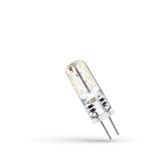

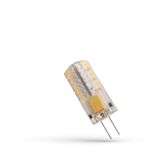
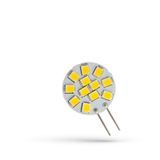
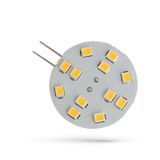
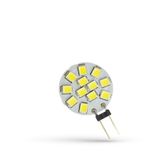
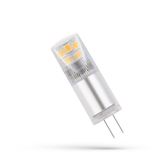

spectrum g4 led bulbs formats and wattage nodes
G4 capsules keep the 2-pin, 4.0 mm pitch footprint for miniature fittings, furniture spots, plinth lights, and chandeliers. Power classes typically span 1.2 W, 1.8 W, 2.5–3 W, and 4 W, replacing ~10/15/20–25/35 W halogen with ~100–450 lm depending on optic and CCT. Envelopes include clear silicone “capsule” bodies for near-omni output, flat disc PCBs for forward throw, and compact “tower” builds for higher center intensity in tiny shades. Usual colour packs: 2700 K/3000 K/4000 K; CRI 80 standard with CRI 90 (R9>50 on select bins) for wood, food, and textiles. Operating windows commonly −20…+40 °C; Tc ≤ 85 °C. Lifetime claims sit around L70/L80 25–35 kh on micro capsules and up to 50 kh on thermally loaded discs when installed with airflow.
spectrum capsule led lamps optics and colour quality
Disc types deliver ~110–140° beams for task accents; capsule bodies read ~270° for “sparkle” in multi-arm chandeliers. High-density SMD or COB packages pair with opal silicone for soft luminance or with clear encapsulant for punch. Project-grade lots hold colour within ≤3 SDCM across batches; glare control accessories include micro-diffusers for glass chimneys. Professional SKUs target flicker metrics around PstLM ≤ 1.0 and SVM ≤ 0.4 on compatible drivers—useful where cameras are present.
spectrum low voltage g4 lighting drivers and dimming
All lamps are 12 V nominal; many accept AC/DC, some are DC-only (polarity marked). Legacy electronic transformers demand a minimum load and specific dimmers; where channels are lightly loaded, a constant-voltage 12 V LED driver per group is the reliable path. Dimming is on the primary side only (phase-cut); trailing-edge (RC) is quieter and extends life. PWM or hybrid regulation inside the lamp governs low-end behaviour; keep channel load within the dimmer’s stable range to avoid shimmer. Surge ride-through is typically 0.5–1 kV—fit upstream SPD where motors share the board.
spectrum g4 retrofit led lamps installation notes
Pin diameter and spacing follow IEC 60061; holders must match the lamp neck profile inside small glass shades. Use T-rated lampholders (≥T120…T150) in enclosed cups; avoid insulation touching the capsule—elevated Tc shortens life and shifts colour on CRI 90 nodes. Verify clearance: many discs sit 9–13 mm high; chandelier arms with narrow throats may prefer slim capsules. For DC-only SKUs, observe polarity; for AC/DC types, keep secondary runs short to limit drop (≤0.5 V preferred on 12 V).
Standards and safety you’ll actually use
- LED modules: EN/IEC 62031; control gear inside lamp: EN 61347-2-13, IEC 62384.
- Marking and EMC: EN 62560 (where applicable), EN 55015/EN 61547; mains quality seen at the driver: EN 61000-3-2/-3-3.
- Photobiological safety: EN 62471 RG0/RG1 on typical outputs.
Ingress is generally IP20 at the lamp; the luminaire provides the environmental rating.
Families at a glance (by build style)
- Mini capsule – the smallest bodies for tight glass chimneys and cabinet dots; this is where the phrase spectrum g4 small led bulbs usually appears on schedules.
- Flat disc – forward-throw, compact height, best for recessed “button” fittings and joinery under-lights
- Tower – multi-face emitters for more centre intensity in pendant cups.
- Decor capsule – tinted or frosted shells for visible lamps in chandeliers; ideal when specifiers call them spectrum g4 decorative lights.
Across these, you’ll also see ultra-compact lots that planners shorthand as spectrum miniature led bulbs for museum cases and jewellery vitrines.
Applications and optic selection
Chandeliers and sconces: omni capsules at 2700 K, CRI 90 for warm ambience. Joinery and plinths: discs at 3000/4000 K to throw forward onto worktops. Display cases: narrow-emission towers with 3000 K CRI 90 and low flicker to keep metals and fabrics honest. Boats/RVs: AC/DC capsules tolerate small inverters; confirm ripple tolerance if radios sit nearby.
Quick engineering pointers
- Beam and lm: choose disc for forward task, capsule for omni sparkle; target 150–250 lm for decorative arms, 250–400 lm for small task heads.
- Driver path: LED-rated transformer with adequate load, or a dedicated 12 V CV driver per circuit.
- Dimming: trailing-edge preferred; declare dimmer type on drawings.
- Thermal: enclosed shades → de-rate; keep clearance around the crown.
- Colour: 2700 K for dining/lounge, 3000 K mixed areas, 4000 K display; lock CRI per task.
Compatibility cross-notes
These capsules drop into the brand’s G4 lampholders and miniature canopies; roses, strain reliefs, and braid clamps from the accessory catalog keep cable exits tidy. Where pendants or MR16 accents sit nearby, align CCT/CRI to avoid colour steps between zones.